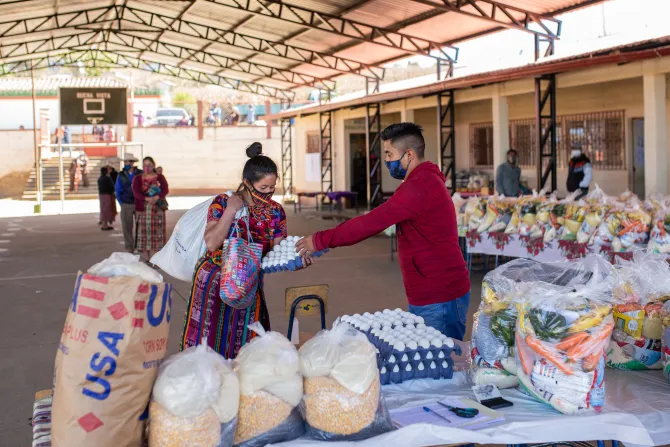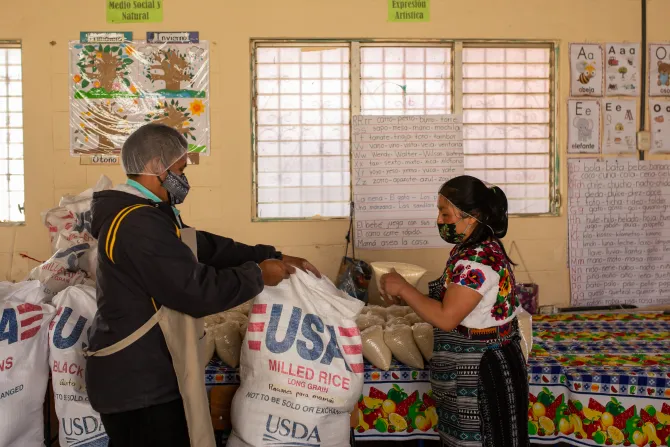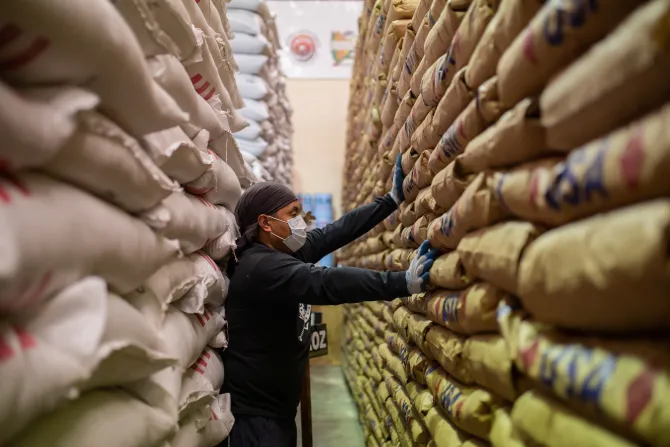Totonicapán, Guatemala, Aug 18, 2021 / 15:05 pm
María Quiró lives with her three sons and four daughters in Totonicapán, in the Western Highlands of Guatemala. Her husband migrated to the U.S. a few years ago to find employment, and she has been without work for more than a year because of the COVID-19 pandemic. Without a steady income, Quiró quickly ran out of money and was not able to feed her children.
“People monopolized all the grain, and the corn and beans ran out, the prices rose, and every day it was more challenging,” Quiró said. “My children asked me for bread, and I had nothing to give them.”
In a normal year, Quiró’s children would eat a meal at school as part of Catholic Relief Services’ (CRS) Learning for Life Project, supplied in part by the United States Department of Agriculture’s McGovern-Dole International Food for Education and Child Nutrition Program.
The McGovern-Dole Program provides U.S. agricultural commodities, such as rice, corn, and beans, to support school feeding projects around the world. Many families in the Totonicapán department depend on government-supported school feeding programs, which provide a complete meal for every child each day of the week.
In Guatemala’s Western Highlands, nearly 70 percent of children are malnourished. The lack of adequate and nutritious food also has a direct impact on other problems of poverty, such as the separation of children from families because their families cannot afford to keep them.
“Guatemala is not the best place for a child to grow up,” said Brenda Urizar, youth and childhood program manager for CRS in Guatemala. “There is a lack of access to services like education, health, and psychosocial support, and a lack of opportunities.”
When children arrive at school, they have often already experienced acute malnutrition, which has a significant impact on a child’s physical and mental development.
“What we do with this food is compensate—at least as much as we can—in the development and the growth of the children,” Urizar said.
When the pandemic began in March 2020, CRS worked quickly with the USDA and the Guatemala Ministry of Education to ensure that students who were eating at school received an equal amount of food to eat at home during remote learning.
“Before the pandemic, we already had this critical situation for children,” Urizar said. “The pandemic exacerbated it and added another layer of problems for families.”
Schools in Guatemala closed in March 2020, and most remain closed today. With an academic year that extends from January until October, students are approaching two years without setting foot in a school building as a result of the pandemic.
To meet the needs of the students learning from home, Urizar consulted her team and modified the supply chain to continue the school feeding program while the children were not attending school in person.
“[The] USDA approved Take-Home Rations for program beneficiaries during school closures,” said Shane Danielson, senior director of the International Food Assistance Division with the USDA. “In addition, USDA has worked with implementers to adapt program activities as best-fit during this global pandemic.”
Volunteers assembled the individual food rations from the McGovern-Dole Program, along with fresh produce from another local project.
CRS established protocols for the parents to come safely to the school to pick up the food, which included hand sanitizing stations, mandatory mask wearing, and social distancing. Less than one month into the pandemic, they were ready to distribute food. Using the megaphone in the center of each town, community members called others to come to the school to pick up food.
(Story continues below)
“It showed us how people came together as a community to support their children,” Urizar said.
During the 2020 school year, 47,515 boys and girls received meals through take-home rations.
Though the initial McGovern-Dole Program funding expired in 2020, CRS in Guatemala was selected for a follow-up award, which extends the program through 2025.
“Guatemala demonstrates significant needs in the areas of education, nutrition, and health; meets the criteria to be a recipient country of McGovern-Dole funding; and has been designated a priority country for funding,” Danielson said.
According to CRS, the school feeding program has been shown to increase school enrollment retention and engagement in daily lessons, and decrease illness.
“CRS has been able to make many improvements in the areas of food security, child health and nutrition and education,” Danielson said. “[The] USDA considers CRS a strong implementing organization and it is pleased to continue this relationship and build on its success.”
For families like Maria Quiró’s, the partnership results in less economic stress on the family situation, and more opportunities for the children to continue their education.
“If my children do not eat properly, they have a headache when they are doing their work,” Quiró said. “I am very grateful for the food for my children.”









